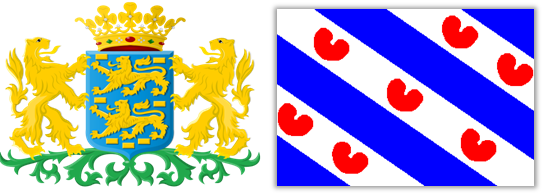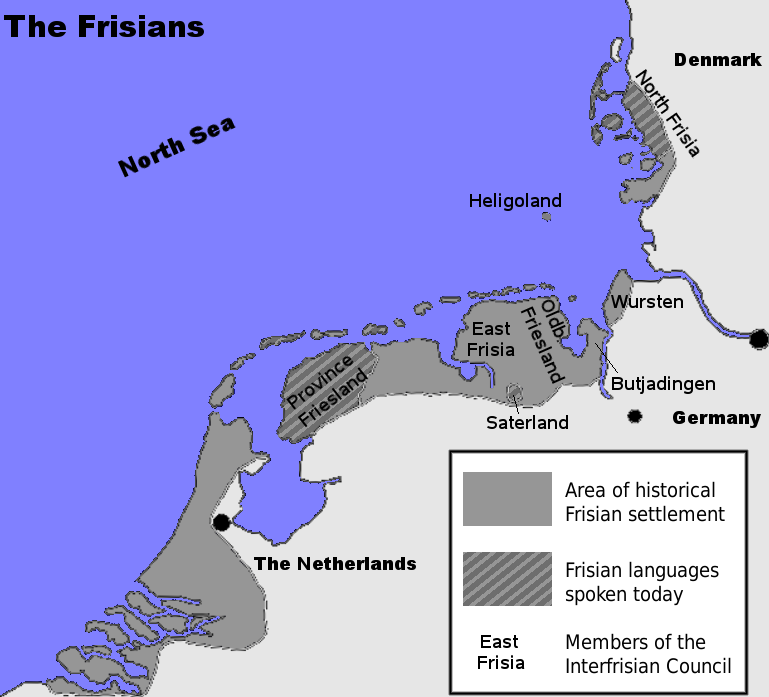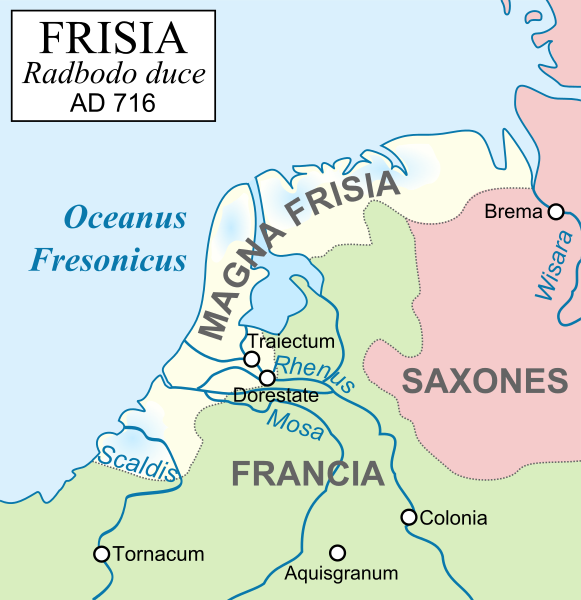The name Frisians comes from the Indo-European word preisios (praises), a conjugation of “prei” which meant dear. “Frisians” thus means “friends / relatives”. Friesland knew so-called “Frisian freedom”. This means that no ruling class (e.g. an by marriage and/or oath interconnected “upper class”) was formed.
Actually Frisian lands were just a large collection of farmer-republics. They rarely agreed with each other, each invoking that famous “Frisian Freedom.” In the Middle Ages representatives of all communities, the chieftains, traditionally came every year to the Upstalboom in Aurich (now Germany) to achieve, as far as possible, unity in administration and policy. Even their laws and penalties (known from 800 AD) were not interpreted in all regions equally. By that proud liberty: “the farmer must keep the reins himself” there occurred no real Frisian state.
Note:
It is a bit similar to the Polish: a man on his farm is equal to the governor (wojewoda).
The Frisian freedom
As an example of the old Frisian fragmentation we can regard the old divisions of the province of Friesland, which formerly included eleven cities and thirty “grietenijen”. The grietmannen (chieftains) of those communities were on behalf of those (11 and 30) communities assigned to the annual meetings where decisions (in all which grietenijen or not at all were concerned) were taken. Because the position of each district chief was determined by his supporters (they had “orders and the duty to consult their counsels at home”) they struggled to decide.
By that fragmentation making any decision was indeed very difficult. In the present Dutch conversation “on his eleven and thirty” still means a very slow and difficult decision making. Through this lesson all elected deputies in the Netherlands swear by accepting their mandate, among other things, that they will act without “any orders and consultations”.
The old provincial organisation (one of the former seven Frisian lands).
There were thirty “grietenijen” combined into three “quarters” and a fourth “quarter” for the eleven cities:
- Oostergo
(East-Shire): Achtkarspelen, Dantumadeel, Ferwerderadeel, Idaarderadeel Kollumer-land & (Nieuw-) kruisland, Leeuwarderadeel, Oostdongeradeel, Rauwerder-hem, Smallingerland, Tietjerkstradeel and Westdongeradeel. - Westergo
(West-shire): Baarderadeel, Barradeel, het Bildt, Menadumadeel, Franekeradeel, Hemelumeradeel & Oldeferd, Hennaarderadeel, Wonseradeel and Wymbriseradeel. - De Wouden
(The Woods): Ængwierda, Doniawerstal, Gaasterland, Haskerland, Lemsterland, Oost-stellingwerf, Opsterland, Schoterland, Utingeradeel and West-stellingwerf. - The eleven towns:
Leeuwarden, Dokkum, Drachten, Franeke, Harlingen, Heerenveen, Joure, Lemmer, Sneek, Wolvega and IJlst.
Note:
The current county now has one provincial government and 24 municipalities! With the old format, the village where their councils meet now often has a name different from the municipality (the group of villages) that is governed by that board.
The province of Friesland
The capital city is Leeuwarden. The province is bordered on the east by the provinces of Groningen and Drenthe, in the south of Overijssel and Flevoland, in the west on the IJsselmeer and on the north by the North Sea. Further it includes the Wadden-islands: Vlieland, Terschelling, Ameland, Schiermonnikoog and three uninhabited islands as well as the protected (a reservate) island Griend. Besides the polders Bildt (made by immigrants from Holland) in the north and the Saxon Stellingwerven (taken from the Saxonian province of Drenthen) in the southeast, the province is Frisian in “language and culture”. Everyone learns Dutch at the school (besides Frisian). Dutch is thus actually their second language. In the capital Leeuwarden a Dutch-Frisian dialect is predominantly spoken. The province has a population density of 194 inhabitants/km².

Provincial coat of arms Provincial flag
The coat of arms is held by two Dutch lions as supporters and is covered with the counts crown. The shield shows two lions, one for the Frisian lands in the Netherlands and one for the Frisian lands in present Denmark and Germany. The seven golden blocks depict the original Frisian countries. Also on the flag these seven countries are symbolically depicted as pompeblâren. The four blue bars remember the four major rivers Wisara (Weser), Rhenus (Rhine), Mosa (Meuse) and Scaldus (Scheldt) that cut the old Frisian lands.
Provincial broadcast: Radio Fryslân & Omrop Frislân TV & Teletext (in Frisian).
Frisia in a birds eye & Weather in Frisia & Weather warnings in Frisia.
Frisian Government & Frisian “states” (Parliament) photo’s.
Frisian academy & Tourisme in Frisia.
Provincial anthem: De âlde Friezen (in Frisian)
Frisian English:
-1- -1-
Frysk bloed tsjoch op! Frisian blood, feel your value!
Wol nou ris brûze en siede, Go to rise now roar and seethe,
En bûnzje troch ús ieren om! Be proud, because you are a Frisian!
Flean op! Wy sjonge it bêste lân fan d’ierde,Come on! Sing of the best country on earth
It Fryske lân fol eare en rom. The Frisian land full honour and fame.
Refrein Refrain
-2- -2-
Ompolske fan it hege salte wetter, Around attacked by the high salty waters,
Fortroppe op in terp of stins, Grouped together on mound and wierd,
Hien ‘d’âlde Friezen yn de wrâld net, Still knew the Frisians, to save his yard,
Har lân en frijdom wie har winsk. His country, its freedom was dear to him.
Refrein Refrain
-3- -3-
Fij fan it jok stege, frjemde hearen, Not bent by the yoke of the tyrant,
Faek earm ek, mar dochs sterk en frij, Also often poor, but yet strong and free,
d’âlde Fries stânfêst by syn menearen, Kept the old Frisian strictly to their morals,
Hy wie in Fries, as Fries stoar hy. He was a Frisian and as Frisian he died.
Refrein Refrain
-4- -4-
Troch waer en wyn, tsjin need en dea to striden To fight all-weather, fears and need,
Mei‘t gleone swurd yn dízren hân to striden, To fight with a flaming sword in steel hand
Wie wille yn dy fromme, stoere tiden, donated a pious delight in the ancient times,
Wie ‘t foar de frijdom fan har lân. when they feared the freedom of the land.
Refrein Refrain
-5- -5-
Fan bûgjen frjemd en fij fan leavewurden, Never bending and averse to flattery,
Wie rjucht en sljucht har hert en sin! Always was their slogan “right not wrong”!
Syn wurd wie wet; rjocht, sljocht n trou Their word was law, straight and true their
syn leare rules,
Stie s’alle twang en oerlêst it tsjin! Blocked all pressures, kept their meanings
Refrein Refrain:
-6- -6-
Sa faek troch stroarm yn sé bidutsen, In storm often tucked away in the sea,
Oerâlde, leave Fryske grûn. The ancient, beloved Frisian soil,
Waerd noait dy fêste, taeije bân ferbrutsen, Has never broken the hard, tough ties,
Dy’t Friezen oan har lân ferboun! Between the Frisian and his yard!
Refrein Refrain
-7- -7-
Trochloftich folk fan dizze âlde namme, Respectable people with this old name,
Wêz jimmer op dy âlders great! Be always proud of your ancestors!
Bliuw ivich fan dy grize, hege stamme, Be forever a member of the old high strain,
In grien, in krêftich bloeiend leat! A powerful green flowering shoot!
Refrein Refrain
Refrein Refrain
Klink dan en daverje fier yn it rûn, Sing than and thunder proudly around,
Dyn âlde eare, oh Fryske grûn! Your old glory, oh Frisian ground!
Klink dan en daverje fier yn it rûn, Sing than and thunder proudly around,
Dyn âlde eare, oh Fryske grûn! Your old glory, oh Frisian ground!
Frisian inspection march: de jonge prins van Friesland.
Frisian folkdances: Ljouwerter Skotsplouch & Molendansen.
Frisian songs (in Louwers- and in Stads-Fries):
Liwwadder blues & Oudste stapper fan e stad & Mata Hari & Arme Ouwe Jantsje & Folksongs & Skumkoppen & Oktoberlân & Friesland & do Wide See & Heitelân & Lit jim gean, Friezen, & Mear As In Freon live in Cultipop & Paradise by the Dashboard Light.
More Frisian songs in: Music from the Provinces.
History of Friesland
The oldest history of Friesland is similiar to that of the province of Groningen. For the Netherlands, for all provinces, it means that the Christian monks have erased almost all written “pagan” information during the Christianization of the region. Very few words (in ancient runes!) are preserved on a few grave gifts (helmets, swords and shields). Related Angles tribes lived east of the Frisians and via Friesland (incorporating most Frisians) they moved to England. This explains the close relationship between the Old English and the Old Frisian language.
There’s been probably about 2,500 years spoken (not written) by Frisians. They came from northern Poland and northern Germany to the North Sea coasts in southern Denmark, northern Germany (North Frisians), Northwest Germany (East Frisians) and the Netherlands (West Frisians). West Frisians inhabited roughly the present provinces of Friesland, Groningen, North Holland, South Holland, Zeeland and the western part of Utrecht. Until the Middle Ages the city of Utrecht was their capital. Their southern boundary is difficult to determine. A “hard” line here is defined by the Sincfal (current Dutch name: Zwin – the beach border between the Dutch province Zealand and the Belgian province Flanders), but the idea that once the Frisian area extended into northern France seems topographic not excluded. At that time the name “Frisians” (as now the name “Hollander”) was used for all the residents of the Netherlands. (The “Northsea” was called “Frisian Sea”, the church they built in Rome is still called the “Frisian church”, etc.).
The name West-Frisians is still worn by inhabitants of the northern part of the province of North-Holland. Southern part up to the big rivers is inhabited by the Hollanders (Batavians and Frisians mixed with some Canninifats) and in south of those big rivers the Zeelanders (Flemish and some Frisians mixed with some Batavians) live. In the province of Friesland today the Louwerse (or Mid-) Frisians are living.
Due to the rise of the sea-level in the 3rd century the area between the current Friesland and North-Holland became permanent flooded and the present province of Friesland was depopulated. As a result “Holland” (the Noorderkwatier & South Holland, Zeeland and Utrecht and pieces of Brabant) became dominant and the Counts of the area called themselves (after about 1000) “Count of Holland, Zeeland and (a bit later) West Friesland”.
Friesland 716
In the time of the Holy Roman Empire Frisian countries developed an own form of independence, called the “Frisian Freedom”. Until the 13th century, Counts of Holland and the Bishop of Utrecht exercised authority only to a decreasing extent. Beeing descendants of the Frisian kings (foreigners often call them “dukes”), the counts of Holland wanted actually to exercise power to make the laws work also to levy taxes. So there was an army of knights send out to set things right.
The final battle of Warns
(26 September 1345, Leaver dea as sleaf! = Better dead than slave!)
Because of tactical errors and poor coordination of the Holland armed forces, in which also French, Flemish and Sealandian knights served (horses for the heavily armored knights were not loaded into the ships!), also for resistance much stronger than expected (Scotsmen had joined the Frisian side) The “Hollander” lost the battle and had to flee home. The decisive encounter had place near the Red Cliff where Frisians every year (on the last Saturday in September) up until today commemorate this battle.
This victory also kept the “Frisian Freedom” in position so that the severe civil war between “Schieringers and Vetkopers” in Friesland went forth a 150 years longer in all its fierceness. In 1498 Emperor Maximlian I appointed his vassal Albert of Saxony to be the podesta (governor) of Friesland. That way the “Frisian Freedom” ended.
In 1579 Friesland joined, as last province, the Union (of the “Seven United Provinces”).
A Frisian saga 1
The special significance of Fosite to the Frisians, according to a well-known version of the legend which tells how the Emperor Charlemagne, the Frisians conferred the Frisian freedom on the condition that they codified their laws with their regional variations. Codifying the Frisian laws was entrusted to twelve Asega’s (Frisian judges). They produced, year after year, no result so the emperor set them an ultimatum: in a certain period of time they had to complete their work, otherwise they would be put on a ship without a helm and sail and send onto the sea. Indeed, they did not get it right and the sentence was executed. The ship came into a heavy storm and the twelve judges believed that they were all going to die, when suddenly saw a thirteenth man on board of the rudderless ship, who inexplicably steered the ship ashore. This was the god forsite. Arrived on land Forsite hit with his staff on the ground. In that place sprang a source. Forsite invited the twelve judges, to take place around that source. He himself took place on a large stone and then dictated the judges the Frisian laws. So they went to the emperor and secured the “Frisian Freedom”.
Note 1:
Many places claime to be the stage of the meeting led by Forsite. Famous places are Heilbron at the foot of the North Frisian Stollberg, the rocky island of Helgoland (on old maps also marked as “Fositeland”) and the island of Ameland. Even the village of Zeerijp (zie Groningen) is considered.
Note 2:
The memory of Forsite is in Friesland (not only in the Dutch part) kept alive in a more or less serious way, and at the Friesen-droapen on Helgoland, by placing an extra seat for Forsite at meetings.
Note 3:
The old Germanic laws were never written down, they had to be memorized. At a time when a large part of the population could not read, that was the only way to make the laws known and respected. Until after the Second World War, by tradition, throughout the Netherlands (major) new laws were read by “loud voice”! on the steps of City. After that they were in force.
A Frisian saga 2
There was a rich merchants widow, in Stavoren, who wished an ever growing wealth. So she sent her commander (chief of her captains) the order to visit all major ports and return with the most precious of what he, on that journey, would see. The sailor visited many ports, but nowhere he saw something that he considered the most valuable in the world. When he arrived in Danswijk (Polish: Gdansk) in Poland, he saw on the market there, the “golden grain” and loaded his ship with it full.
Back home, he told the woman that the most precious thing he could find was “corn because it feeds every hungry person.” The widow was kindled in anger and asked “which side, port or starboard, you have the grain loaded?” On the port side, the sailor replied. “Very good,” she said, “put it, in front of the harbour, overboard at the starboard side.”
An old man of the people, who stood close to her, grabbed so much by this waste, he excitedly shouted to her: “You will be punished for your insolence! There comes a time when you will go begging ” Cold she turned around, took a precious gold ring from her finger, threw it in the waves and said!” Not sooner as this ring returns from the sea, I will go to beggary for food”.
Soon after tis, during a banquet for her colleagues of the Hanseatic League, she found her ring in a fish that was served to her. As the old man predicted, she was struck by one disaster after another, and they fell into deep poverty, and she had to beg for a piece of bread.
The grain germinated for the port and the roots kept more and more sand and earth fixed. The port was closed by it for larger ships. Thus fell the whole, once so rich city into a small village of less than 1,000 inhabitants, in deep poverty.
About Friesland in short.
Ameland
The oldest known West-Germanic (the “mother” of Frisian and Dutch) word is “wad”. It is used in a letter that the Greek merchant Pytheas of Massalia (looking for the origin of amber, wrote on the island of Abalus (Ameland?).
The linguistic Prof. Nicoline van der Sijs (van Dale, Chronologisch woordenboek) dates that written word in 500 BC., The historian Geert Mak (Ooggetuigen van de vaderlandse geschiedenis) thinks about 325 BC.
Eise Eisinga Planetarium.



